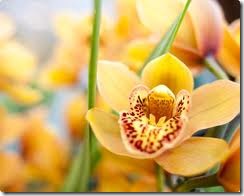Cymbidiums are most often grown indoors (or in greenhouses) in pots, but they are also the best-suited orchid variety for outdoor culture, especially in places like the coastal regions of California, along the Mediterranean coast, New Zealand, Australia and South Africa. Cymbidiums can be grown outdoors in any place with a similar climate and the right temperature cycle. Flowers come in all colors, except blue and true red, and they range in size from 1 to 6 inches in diameter.
Identification
-
Cymbidium orchids are often seen in corsages. The flower petals are thick, hard and waxy. Cymbidiums have short, thick stems called pseudobulbs. These stems store water and bear multiple, strap-like leaves. Healthy foliage is light green. Yellow or dark green foliage indicates a light or water deficiency.
Water Requirements
-
When cymbidiums produce new growth, especially during the warmer months, they should be watered frequently with a volume of water at least equal to that of the pot. On very hot days (90 to 100 degrees Fahrenheit), the plants should be periodically misted with water. Watering orchids with tap water leads to mineral buildup in the soil, as well as buildup of salts. This leads to greater water consumption. Use purified water when watering orchids. During the winter months, when the cymbidium is not producing new growth, keep the potting medium barely moist but never dry. When indoors, pots should be set on a pebble tray (a shallow tray full of pebbles) filled with water. The water in the tray should not touch the bottom of the pot.
Sunlight
-
The Cymbidium Society of America recommends that cymbidiums receive as much filtered sunlight as possible. It advises that pastel flowers will benefit from the filtered sunlight without the dark pigment "staining" of the petals that direct sunlight can produce. It recommends a propylene shade cloth with a density of 55 percent to cover cymbidium growing areas. Colorado State University (CSU), however, recommends "very high light" for excellent flower production.
Temperature
-
Cymbidiums can tolerate summer heat and the chill of winter. The right amount of heat, light and water are all necessary components of flower production, but so is the right amount of cold weather. Cymbidiums can tolerate short periods where temperatures reach 100 degrees Fahrenheit and drop to 29 degrees Fahrenheit. However, large-flowered cymbidium varieties require a six- to eight-week cool period in the fall to ensure flower production the following season. Keep plants outdoors starting in early spring and bring them indoors after the first frost.
Soil or Potting Medium
-
Cymbidiums should be potted in a combination of organic and mineral materials. Cymbidiums can also be grown in raised beds, provided they have a free-draining, acidic soil. The potting medium, according to CSU, should be redwood bark chips, coarse charcoal or perlite, and unmilled sphagnum moss or coarse peat moss to enhance water retention.


Deprecated: strpos(): Passing null to parameter #1 ($haystack) of type string is deprecated in /home/agriviek8Qv/agriviet.net/public_html/wp-includes/comment-template.php on line 2522